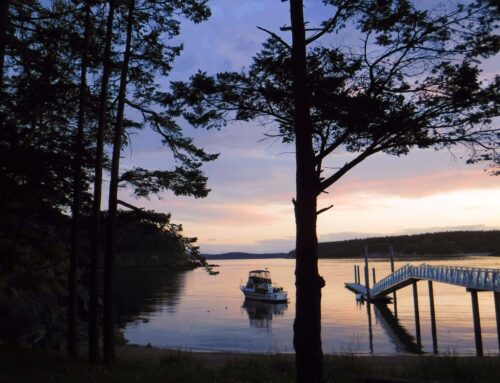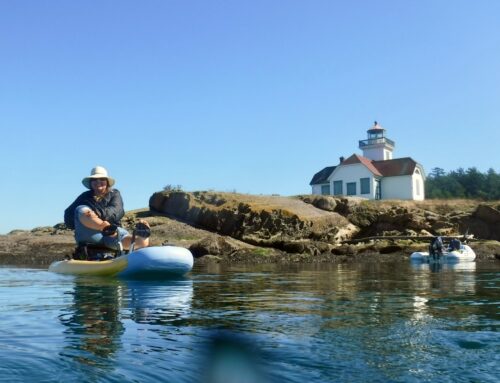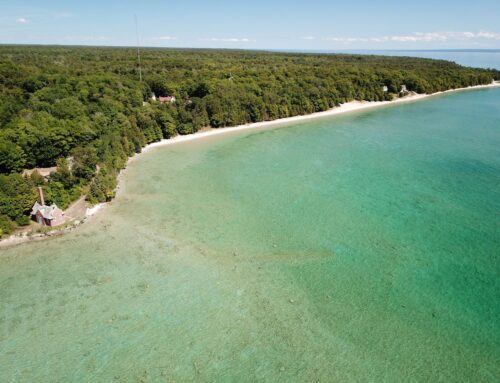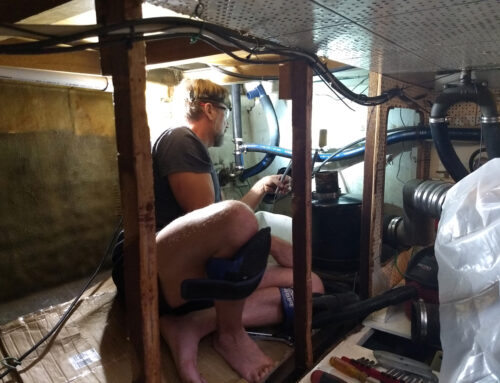A friend of mine recently asked why the heck I was not out on the water yet. It is a friend that does not own a boat, so I tried to explaining that we still have projects to complete. They looked confused because we had been “working on the boat” all winter. It is hard for someone to understand all the little things that add up to projects on a 26′ boat. Another friend of mine – who is a boat-owner – asked about the boat , all I said is there is still much to do, he nodded his head knowingly and we discussed project lists.
I have found in my not so experienced sailing career that the projects never end. There will always be something hanging over your head; and to keep the right things hanging over your head – most notably the boom and sails – one must ignore some of the more trivial projects.
I decided to summarize what I have already done and what still needs to happen in order to get on with my summer, which is hopefully coming soon (the lists are below). It is always good to start with the engine. I know it is a sailboat, MacGregors however are powerboats of some sorts as well and without the engine it is difficult to get anywhere on the river. Thankfully Webfoot has a very trusty BF50 Honda outboard. For the non-technical that is a 50 horsepower engine that hangs off the transom (back-end).
We started engine work late last summer with a trip to a good mechanic who has worked on a lot of engines. He dismantled the carburetors and ran the parts through a state of the art parts washer that gets all of those tiny little annoyances out of the most difficult places. The mechanic replaced all of the gaskets with genuine Honda parts ($$$) and then synced the three carburetors so that they would work in unison. The mechanic also pressure checked the lower unit and replaced a gasket.
After the $850.00 trip to the mechanic we took his advice and installed a fuel water separator (Moeller-Separating-Filter![]() ) in hopes of avoiding the damage that ethanol may do to the engine. Before taking the boat to the mechanic I replaced the gas tanks, fuel lines, connectors, and fuel filter. After every use I run the engine out of gas by disconnected the fuel supply and then drain the fuel bowls on the carburetors.
) in hopes of avoiding the damage that ethanol may do to the engine. Before taking the boat to the mechanic I replaced the gas tanks, fuel lines, connectors, and fuel filter. After every use I run the engine out of gas by disconnected the fuel supply and then drain the fuel bowls on the carburetors.
Late in December it was getting pretty cold around here, a few times it was dipping below freezing. I lay in bed at night thinking of that small cavity somewhere deep in the engine block that still had water in it. I was imaging that water freezing, expanding, and eventually destroying the engine block. With this unpleasant thought in mind I headed to West Marine to grab some winterizer.
To start the winterizing of the engine project I warmed up the engine as I usually do, so that the thermostat would be open and this will allow the coolant to run through the entire block. My big mistake was that I purchased some engine muffs that did not fit all that well. After turning on the hose and starting the engine to let the coolant run through the engine block the muffs slipped off. Maybe it was the unusual sunshine that distracted my attention…but when I checked on the the water return there was nothing coming out. Horrified I shut the engine off. After a few more attempts with the muffs and no water return I put the engine back into the water bath.
 |
| I use the cooler liner as a “water bath”, works great! |
With the engine running, the water would not consistently stream out of the pee hole, yikes. My first thought was that the impeller had melted to the point of dysfunction. Once I opened the water pump housing I realized this was not the case, hmmm strange. Impeller looks like new and still no water return??? So after beating my head against the wall I came up with the idea the thermostat was damaged. I went to the point of installing a new thermostat and still had the same problem. I flushed and flushed the system, still no dice. Then I went and checked the water pump again to see if I missed something, lets see the impeller looks brand new. But wait check out the lower water pump housing. Looks like somebody had taken a cigarette lighter to it. The lower housing was melted just the slightest bit, I reasoned that the pump must not be building up enough pressure to push water through it effectively. Eighty dollars later I had a new water pump housing installed with all the trimmings. Now she is “peeing” like a champ!
One other problem that I noticed while digging around the thermostat is the amount of corrosion on the thermostat. After I did some web surfing and found a post by a very ambitious Honda enthusiast who was rebuilding his entire engine which helped me to decide it was time to replace the internal sacrifical zinc. There is a manual that I checked out at the library ( Seloc Marine Engine Maintenance And Repair Manuals Honda Outboards) that helps the average do-it-yourselfer with these types of projects.
Another routine maintenance item that I vowed to keep on top of, after seeing the amount of corrosion that can develop after a long rainy winter, is the steering tube. I have read more than a few posts that mention the difficulty of steering when this tube gets corroded. It might even seize up unexpectedly and leave you somewhere you do not want to be. It takes only about 5 minutes and is very much worth it to keep the steering tube well greased.
One quality about the German captain, whom I share the boat with, that I admire is her strict adherence to order. She needs a proper place for everything and I am beginning to see the light on how having a proper place for everything can be extremely beneficial if only to keep the peace aboard the boat. One of the items that creates disorder on our boat the most is books. By now you should know how spartan a MacGregor comes from the factory. I broke out the power tools and went down to the hardware store for some shelving material.
I do not necessary like to make modifications to the boat that can not be easily unmodified. I hate drilling holes in the boat, even the interior liner that does not have any structural purpose on the boat. So I decided to use an excellent adhesive that would allow me not to have to drill holes in the liner: Gorilla Super Glue![]() . I glued on some scrap 1″x2″ pieces to the liner and then screwed 4″ and 6″ strips of ply to the 1″X2″s. The result is sturdy and effective book shelving/junk drawers that in my eyes looks pretty darn good.
. I glued on some scrap 1″x2″ pieces to the liner and then screwed 4″ and 6″ strips of ply to the 1″X2″s. The result is sturdy and effective book shelving/junk drawers that in my eyes looks pretty darn good.
The next project will be installing an anchor light. This item is one that all Macs lack coming out of the factory. We purchased an all around LED white light![]() as well as 40′ of 16 gauge wire and a Perko replacement plug
as well as 40′ of 16 gauge wire and a Perko replacement plug![]() . We will keep you posted on how that progresses. Please let me know if I can answer any questions about my upgrades, I would love to hear about your projects as well.
. We will keep you posted on how that progresses. Please let me know if I can answer any questions about my upgrades, I would love to hear about your projects as well.
Examples of some of the items on my to do list may be found at http://www.macgregorsailors.com
PROJECT LIST
Engine
Replace internal anode
Carburetors rebuilt last season
Oil Change
Replace throttle cables
Replace Water pump
Replace Fuel Filter
Install New Fuel Tanks
Install New Fuel Line
Install Fuel Water Separator
Prop tune
Fresh gear lube
Deck
Gas Tank Covers
Replace 12v sockets
Anti Screech tabs in sliding hatch
Cut hatchboard into 3 pieces
Install fishing rod hangers
Install Anchor light
Install Down rigger
Fit Bimini
Cabin
Install Bilge Pump
Ventilation in Head Compartment
Composting Toilet
Bookshelves
Replace Plumbing to thru-hulls
Double secure all thru-hulls
Galley
Install cabinet shelving
Install water system
Steering
Lube cables






Leave a Reply